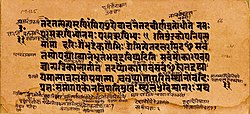
Back মাণ্ডূক্যোপনিষদ্ Bengali/Bangla Mandukya-Upanishad German Mandukya-upaniṣad Spanish اوپانیشاد ماندوکیه Persian Mandukya Upanishad French माण्डूक्योपनिषद Hindi Māṇḍūkya Upaniṣad Italian マーンドゥーキヤ・ウパニシャッド Japanese ಮಾಂಡೂಕ್ಯೋಪನಿಷತ್ Kannada Mandūkja Upanišada Lithuanian
| Mandukya | |
|---|---|
 Mandukya Upanisad verses 1 to 3 (Sanskrit, Devanagari script) | |
| Devanagari | माण्डूक्य |
| IAST | Māṇḍūkya |
| Type | Mukhya Upanishad |
| Linked Veda | Atharvaveda |
| Verses | 12 |
| Commented by | Gaudapada, Adi Shankara, Madhvacharya |
| Part of a series on |
| Hindu scriptures and texts |
|---|
 |
| Related Hindu texts |
The Mandukya Upanishad (Sanskrit: माण्डूक्योपनिषद्, IAST: Māṇḍūkyopaniṣad) is the shortest of all the Upanishads, and is assigned to Atharvaveda.[1] It is listed as number 6 in the Muktikā canon of 108 Upanishads.[2]
It is in prose, consisting of twelve short verses, and is associated with a Rig Vedic school of scholars.[1] It discusses the syllable Aum; adds turya to the three states of consciousness; and asserts that Aum is Brahman – which is the Whole – and that Brahman is this self (ātman).[3][4]
The Mandukya Upanishad is recommended in the Muktikā Upanishad, in a dialogue between two of the most important characters of the Ramayana, Rama and Hanuman, as the one Upanishad that alone is sufficient for knowledge to gain moksha, and as sixth in its list of ten principal Upanishads.[2] The text is also notable for inspiring Gaudapada's Mandukya Karika a classic for the Vedanta school of Hinduism.[2] The Mandukya Upanishad is among the often cited texts on chronology and the philosophical relationship between Hinduism and Buddhism.[5][6]
- ^ a b Cite error: The named reference
pauldeussenintrowas invoked but never defined (see the help page). - ^ a b c Paul Deussen, Sixty Upanishads of the Veda, Volume 2, Motilal Banarsidass, ISBN 978-8120814691, pages 556-557
- ^ Paul Deussen, Sixty Upanishads of the Veda, Volume 2, Motilal Banarsidass, ISBN 978-8120814691, pages 605-637
- ^ Hume, Robert Ernest (1921), The Thirteen Principal Upanishads, Oxford University Press, pp. 391–393
- ^ Nakamura 2004, p. 284-286.
- ^ Comans 2000, p. 97.
© MMXXIII Rich X Search. We shall prevail. All rights reserved. Rich X Search